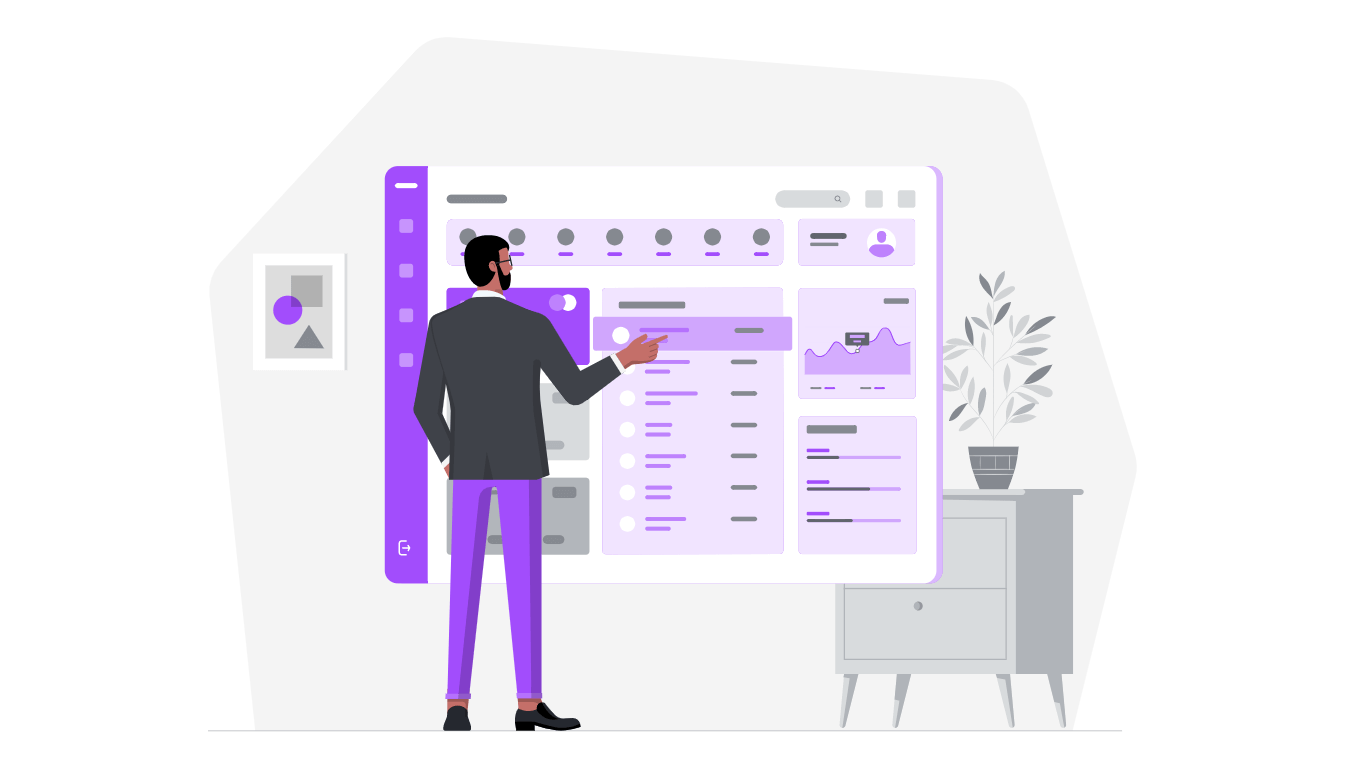Table of Contents
What is a Product Roadmap?
A product roadmap is defined as a strategic planning document or visualization that outlines the high-level goals and objectives for a product or product line over a specific period of time. It is a communication tool that helps a product team, including product managers, developers, designers, and other stakeholders, to align on the product’s direction and priorities. A product roadmap provides a clear, visual representation of how a product will evolve to meet customer needs and business objectives.
Key elements of a product roadmap typically include:
- Timeframe: A product roadmap often covers a defined period, such as a quarter, a year, or several years. It helps stakeholders understand the timeline for product development.
- High-Level Goals: The roadmap should highlight the primary goals and objectives for the product. These goals are typically tied to the product’s vision and the needs of its target audience.
- Key Features and Initiatives: It outlines the major features, improvements, or projects that will be undertaken to achieve the goals. These features are usually described in a high-level manner, without getting into detailed specifications.
- Prioritization: The roadmap indicates the priority of different features or initiatives. This can be done using visual cues like color-coding, labels, or grouping items into categories like “must-have,” “nice-to-have,” or “future.”
- Dependencies: It may also highlight dependencies between different features or initiatives. This helps in understanding the order in which things need to be done and how one feature may impact another.
- Status Updates: As time progresses, the roadmap can be updated with the current status of various initiatives, showing what’s been completed, what’s in progress, and what’s planned for the future.
- Audience: The product roadmap should consider the needs and preferences of the target audience and how they will benefit from the proposed features and changes.
A product roadmap is a living document that should be regularly reviewed and adjusted as the product evolves and as market conditions change. It is a valuable tool for keeping all stakeholders informed and aligned, helping the team make informed decisions about what to prioritize and what direction to take with the product. Roadmaps can take various forms, including visual charts, digital documents, or software tools designed for this purpose.
Product Roadmap Template
Creating a product roadmap template can help you visualize and communicate your product’s strategic plan effectively. Below is a basic product roadmap template that you can use or modify to suit your needs. You can create this template using tools like Microsoft Excel, Google Sheets, or specialized product management software, or even draw it on a whiteboard or paper.
Instructions for using the template:
- Timeframe: Specify the timeframe for your roadmap, whether it’s for a quarter, a year, or a different period.
- High-Level Goals: List the primary goals or objectives you aim to achieve during the specified timeframe.
- Key Features and Initiatives: Create a table to list the features or initiatives you plan to work on. Include columns for priority, a brief description, and target release dates.
- Dependencies: Note any dependencies between features or initiatives.
- Status Updates: Keep track of the current status of each feature or initiative.
- Audience: Define the audience or user segments that will benefit from the planned work.
- Legend: Include a legend to explain the priority levels and any other symbols or labels you use.
You can customize this template by adding more columns or sections as needed, and you can also make it more visually appealing using dedicated roadmap software or graphic design tools. The goal is to provide a clear, visual representation of your product’s direction and priorities.
Learn more: 8 Useful Product Roadmap Examples
How To Build a Product Roadmap
Building a product roadmap is a strategic process that involves several key steps. Here’s a comprehensive guide on how to create a product roadmap:
- Define Your Goals and Vision
Start by establishing a clear product vision. Understand what you want to achieve with your product in the long term. Your vision should align with your company’s mission and objectives.
- Identify Your Target Audience
Determine who your target customers are and understand their needs, pain points, and preferences. Create user personas to represent different customer segments.
- Gather Customer Feedback and Data
Collect feedback from existing customers, conduct surveys, and analyze user data. This will help you identify what features or improvements are most important to your users.
- Set Objectives and Key Results (OKRs)
Define specific, measurable, achievable, relevant, and time-bound (SMART) objectives that support your product’s vision. These objectives will guide your roadmap and serve as success criteria.
- Prioritize Features and Initiatives
Use prioritization frameworks such as MoSCoW (Must-haves, Should-haves, Could-haves, Won’t-haves), RICE (Reach, Impact, Confidence, Effort), or the Kano model to rank features and initiatives. Consider factors like user value, impact, technical complexity, and business goals.
- Create a Timeline
Choose a timeframe for your roadmap, whether it’s quarterly, annually, or over a more extended period. Align your timeline with your objectives and priorities.
- Set Themes and Categories
Organize your roadmap into themes or categories that reflect your strategic goals. As an illustration, you could have categories such as “Enhancing User Experience,” “Expanding into New Markets,” and “Strengthening Security.”
- Build the Roadmap
Start populating your roadmap with the prioritized features and initiatives. Use a visual format, such as a spreadsheet or dedicated roadmap software, to create a clear and easily understandable roadmap.
- Add Details to Each Item
For each feature or initiative, provide a brief description, the expected benefits, and any high-level technical or resource requirements. Also, indicate who the target audience is.
- Consider Dependencies
Identify and document any dependencies between items. This helps you understand the order in which work should be done and avoid bottlenecks.
- Balance Short-Term and Long-Term Goals
Ensure your roadmap includes a mix of short-term, quick-win projects and longer-term, more strategic initiatives.
- Share and Collaborate
Share your roadmap with relevant stakeholders, including the product team, executives, marketing, sales, and customer support. Collaborate to gather feedback and ensure alignment.
- Iterate and Update
Regularly revisit and update the roadmap to reflect changes in priorities, market conditions, and customer feedback. Be prepared to adapt as necessary.
- Monitor Progress
Track the progress of features and initiatives on your roadmap. Update the status regularly and ensure that everything is on track.
- Review and Reflect
After a specific period or at the end of a release cycle, conduct a retrospective to review what was achieved, what worked well, and what didn’t. Use this feedback to inform future roadmaps.
- Communication and Transparency
Maintain open and transparent communication with stakeholders about the roadmap’s progress and any changes.
Building a product roadmap is an ongoing process that requires continuous feedback, adaptation, and alignment with changing business objectives and customer needs. By following these steps, you can create a roadmap that effectively guides your product’s development while ensuring it remains in sync with your strategic vision.
Learn more: What is a Business Roadmap?
Product Roadmap Strategy
Developing a product roadmap strategy is essential for aligning your product development efforts with your business goals and customer needs. Here’s a step-by-step guide to help you create an effective product roadmap strategy:
- Define Your Vision and Objectives: Start by clearly defining your product’s vision. What problem does it solve? What are the long-term goals for the product? Identify specific objectives that support your vision. These objectives should be measurable and time-bound.
- Understand Your Customers: Conduct thorough market research to understand your target audience’s needs, pain points, and preferences. Create user personas to personify your ideal customers and keep them in mind when designing your roadmap.
- Prioritize Features and Initiatives: Prioritize features and initiatives based on customer feedback, market trends, business goals, and technical feasibility. Use prioritization frameworks like the MoSCoW method, the Kano model, or the RICE scoring system to make informed decisions.
- Create a Clear Timeline: Define the timeframe for your roadmap. This can be quarterly, annually, or longer-term depending on your product’s lifecycle. Allocate features and initiatives to specific timeframes, considering dependencies and resource availability.
- Balance Short-Term and Long-Term Goals: Your roadmap should strike a balance between short-term wins (quick wins) and long-term strategic initiatives. Include quick wins to demonstrate value to customers and stakeholders while working on more substantial, longer-term projects.
- Communicate and Align: Share your roadmap with stakeholders, including the product team, executives, sales, marketing, and customer support. Ensure everyone understands the rationale behind your strategy and how it aligns with the company’s goals.
- Iterate and Adapt: Product roadmaps should be dynamic documents. Regularly revisit and update the roadmap to reflect changing priorities, customer feedback, and market conditions.Be prepared to adapt and make adjustments as needed.
- Use Roadmap Software: Consider using dedicated product management and roadmap software tools to create, manage, and share your roadmap. These tools often offer collaboration features and visual representations.
- Measure and Analyze: Set key performance indicators (KPIs) to track the success of your roadmap. These might include metrics like user adoption, revenue growth, customer satisfaction, and feature usage. Continuously analyze data and feedback to assess whether your strategy is achieving the desired results.
- Feedback Loops: Establish feedback loops with your customers, the product team, and other stakeholders. Regularly gather input to validate your roadmap and make data-driven decisions.
- Risk Management: Identify potential risks and challenges that could affect your roadmap’s execution. Create alternative strategies to minimize the impact of these potential threats.
- Celebrate Milestones: Acknowledge and celebrate achievements and milestones along the roadmap to boost team morale and maintain enthusiasm.
Remember that a product roadmap is a strategic document, not a detailed project plan. It should provide a high-level overview of your product’s direction and help stakeholders understand your strategy. By following these steps and continuously refining your product roadmap strategy, you can improve your product’s chances of success in the market.
Product Roadmap Best Practices
Product roadmaps are essential tools for guiding the development and evolution of products. To create effective product roadmaps, consider the following best practices:
- Start with a Clear Vision
Begin by defining a clear product vision that outlines what the product aims to achieve in the long term. This vision should align with your company’s overall mission and goals.
- Customer-Centric Approach
Understand your customers and their needs through research, feedback, and data analysis. Ensure that your roadmap prioritizes features and improvements that address these needs.
- Set Measurable Objectives
Establish specific, measurable, achievable, relevant, and time-bound (SMART) objectives that support your product’s vision. Objectives provide a clear sense of purpose and success criteria.
- Prioritization Frameworks
Use prioritization frameworks like MoSCoW (Must-haves, Should-haves, Could-haves, Won’t-haves), RICE (Reach, Impact, Confidence, Effort), or the Kano model to rank features and initiatives based on their impact and feasibility.
- Balanced Roadmap
Balance short-term and long-term goals. Include a mix of quick wins and more strategic, long-term projects to maintain momentum and drive innovation.
- Transparency and Communication
Share the roadmap with all relevant stakeholders, including your development team, executives, sales, marketing, and customer support. Regularly communicate updates and progress.
- Frequent Updates
Product roadmaps are not static documents. Update them regularly to reflect changes in priorities, feedback from customers, or new market insights.
- Keep It High-Level
A product roadmap is a strategic tool, not a project plan. Keep it at a high level to convey the overall direction and priorities without diving into detailed specifications.
- Dependency Management
Clearly indicate dependencies between features and initiatives. This helps in understanding the order of work and potential bottlenecks.
- Iterative Development
Embrace an iterative approach to product development. Allow room for flexibility and adapt your roadmap based on ongoing learnings and feedback.
- Data-Driven Decisions
Base your roadmap decisions on data and metrics. Use analytics to track how your product is performing and validate whether your roadmap items are meeting their goals.
- Risk Management
Identify potential risks and challenges that could impact your roadmap. Develop contingency plans to mitigate these risks and minimize disruptions.
- Resource Allocation
Ensure you have the necessary resources, such as developers, designers, and budget, to execute the roadmap effectively.
- Celebrate Milestones
Acknowledge and celebrate achievements along the roadmap. This helps boost team morale and maintain motivation.
- Feedback Loops
Establish mechanisms for collecting and incorporating feedback from customers and the product team. Use this input to validate and refine your roadmap.
- Use Roadmap Software
Consider using dedicated product management and roadmap software to create, manage, and share your roadmap. These tools often provide collaboration features and visual representations.
- Review and Learn
After a set period, conduct a post-launch review of the completed features to learn from successes and failures, informing future roadmaps.
By following these best practices, you can create and maintain a product roadmap that effectively guides your product’s development and ensures alignment with your company’s strategic goals and customer needs.
Learn more: What is an Empathy Map?
Most Recent Posts
Explore the latest innovation insights and trends with our recent blog posts.













